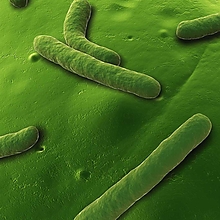This story was originally published in Maryland Today.
 A few years ago, a patient fell into a body of freshwater, gashed a leg on a rock and developed a quickly spreading infection that began eating into flesh, a condition known as necrotizing fasciitis. Unable to bring the disease under control any other way, doctors took drastic measures, and the patient (whose personal details can’t be disclosed) suffered a quadruple amputation.
A few years ago, a patient fell into a body of freshwater, gashed a leg on a rock and developed a quickly spreading infection that began eating into flesh, a condition known as necrotizing fasciitis. Unable to bring the disease under control any other way, doctors took drastic measures, and the patient (whose personal details can’t be disclosed) suffered a quadruple amputation.
Although the infection was originally diagnosed as the work of a single microbe, a new study of the case by a team of scientists that included Distinguished University Professor Rita Colwell used genetic analysis to reveal how two different strains of a single species of flesh-eating bacteria worked in concert to become more dangerous than either strain alone.
The study, which could lead to better medical care for patients with multi-microbial flesh-eating infections, was published on November 12 in the Proceedings of the National Academy of Sciences.
“When we treat with a given antibiotic, we’re clearing an organism out of the body,” said Colwell, an expert of global stature on infectious diseases who holds appointments in the University of Maryland Institute for Advanced Computer Studies (UMIACS) and at the Johns Hopkins University Bloomberg School of Public Health. “But if there’s another organism that’s participating in the infection and that’s also pathogenic, then any antibiotic treatment that doesn’t also target that organism may just be clearing ground for it to grow like crazy.”
Traditional diagnostics could only determine that the patient’s infection was caused by a single species of bacteria called Aeromonas hydrophila. But the disease baffled clinicians when it rapidly turned life-threatening. Through genetic analysis of the culture, Colwell and her team discovered important differences among the individual bacterial cultures that could not be detected through standard diagnostic methods.
In addition to Colwell, Nur A. Hasan, an adjunct associate professor in UMIACS, is a co-author on the paper. He as the chief science officer for CosmosID Inc., a company that Colwell founded and chairs, and which performed metagenomic analysis for this study. The team also included co-authors from the University of Texas Medical Branch.
Both Colwell and Hasan are part of the Center for Bioinformatics and Computational Biology, one of seven major centers in UMIACS.
In two previous papers, Colwell and her colleagues isolated and identified two genetically distinct strains of the bacteria that combined to cause necrotizing fasciitis. In the current study, the researchers manipulated the genetic components of each strain. When they swapped the genetic components that varied between the strains, the team was able to make them behave similarly. By testing the mutant strains in mice, the team determined how the genetic variations affected each strain’s ability to cause infection and interact with the other strain.
The three studies combined paint a clear picture of how the strains, labeled NF1 and NF2, behave both in separate infections and when combined. In single-strain infections, NF1 remains localized, does not spread to the bloodstream or organs and is cleared by the host immune system. NF2, however, produces a toxin that breaks down muscle tissue and allows it to spread to the bloodstream or organs.
When the strains occur together, the story is reversed. In multi-strain infections, the toxin produced by NF2 breaks down the muscle tissue and enables NF1 to travel to the bloodstream or organs where it becomes deadly.
“We’re excited by this very elegant detective work,” Colwell said. “We now have the ability through metagenomics to determine the individual infectious agents involved in polymicrobial infections. With these powerful new methods we can determine how microbes work together, whether they’re bacteria, viruses or parasites.”
—Story by Kimbra Cutlip